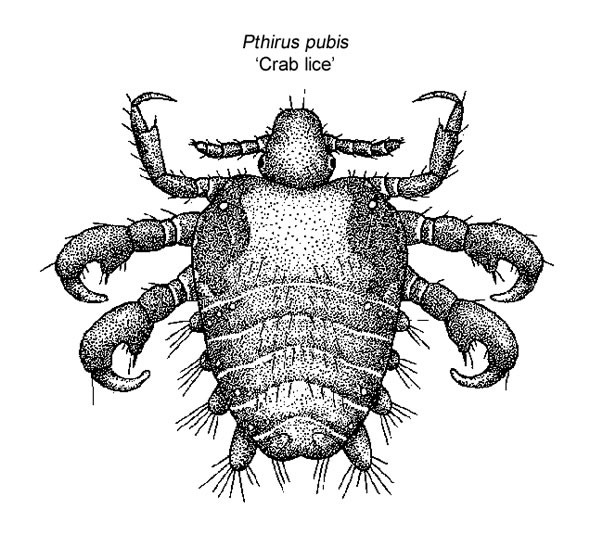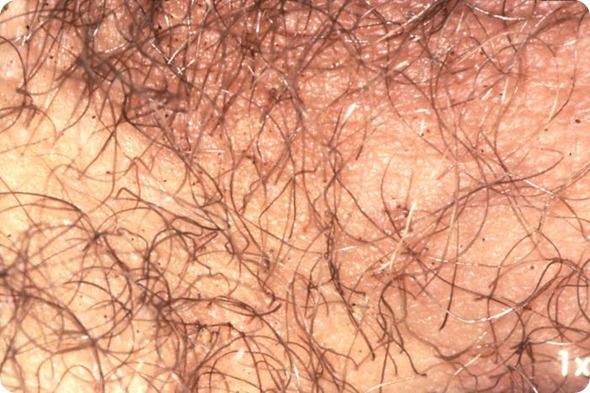Pubic lice (called crabs in common parlance) are caused by very tiny insects called Phthirus pubis. These are parasitic insects that live in coarse human body hair such as hair around the groin.
These lice spread via close contact and are commonly spread by sexual contact. These lice may also infest hair of the legs, armpits, hairs of the chest, back and abdomen, beard and moustaches and very rarely eyelashes and eyebrows.
These lice are different from head lice and do not live in hair over the scalp. In the United States, there are an estimated 3 million cases of pubic lice every year. 1-6
What are the symptoms of crabs?
Once the lice get transmitted to the new host it may take around 5 to 7 days or even weeks before symptoms appear.
The symptoms may be:
- itching in the groin
- irritation and redness (inflammation) of the affected area due to scratching
- blackish powder within the underwear
- lice bites seen as bluish spots on the thighs, abdomen etc.
- and tiny drops of blood in the underwear or clothing
Public lice do not transmit sexually transmitted infections or HIV infection.
What causes pubic lice infestation?
Pubic lice are sometimes called crab lice because they appear like crabs under the microscope. Their second and third pairs of legs have crab-like claws. These claws are used to hold tightly on to hairs.
The lice (Phthirus pubis) as an adult are around 2mm long and are yellow-grey or dusky red in colour. They lay eggs and attach them to the base of hairs. These are called nits.
The eggs hatch into lice after 6-10 days. Female lice can lay up to 300 eggs in their lifetime of 1 to 3 months. These lice can crawl from hair to hair but cannot jump.
Pubic lice can live for up to 24 hours off the body, but because they depend on human blood for survival.
How does one get pubic lice?
Poor personal hygiene is not associated with pubic lice. They are spread through close body contact with an infected person. Sexual contact is the common form of contact that leads to spread of pubic lice spread from person to person.
These lice also spread from person to person if a healthy person shares his or her clothes, towels and bed linen with an infected person. However, the lice and their eggs attach very strongly to hair and do not wash or brush off or fall off on their own accord. This makes sharing clothes etc. an unlikely (but possible) way to catch these lice.
How are crabs diagnosed and treated?
Pubic lice infestation is commonly diagnosed based on symptoms reported and examination of the lice and nits in the affected area. Usually if acquired sexually, the person is also tested for other sexually transmitted infections (STIs).
Pubic lice are treated with medicated lotion, cream or shampoos that are commonly available over the counter at pharmacists. The medication is applied to all the hairy areas on the body except the hair on the scalp, eyebrows and eyelashes. It usually needs to be repeated after three to seven days for complete eradication of the newly hatched louse. 
This photograph reveals the presence of crab lice, Pthirus pubis with reddish-brown crab feces. Pubic lice are generally found in the genital area on pubic hair; but may occasionally be found on other coarse body hair, such as hair on the legs, armpit, mustache, beard, eyebrows, and eyelashes. Image Credit: CDC/ Reed and Carnrick Pharmaceuticals
How to prevent a recurrence of crabs
Prevention of recurrence includes treating household members who are in close contact and sexual partners. All clothing, bed linen and towels etc. need to be washed with hot water and detergents to remove the lice.
Clothing and items that are not washable can be dry-cleaned or sealed in a plastic bag and stored for 2 weeks till the eggs hatch and the lice die off due to lack of feeding on a host.
Sources
- http://www.nhs.uk/conditions/pubic-lice/Pages/Introduction.aspx
- www.bbc.co.uk/health/physical_health/sexual_health/pubic_lice.shtml
- http://www.patient.co.uk/health/Pubic-Lice.htm
- http://www.cdc.gov/healthywater/hygiene/disease/pubic_lice.html
- http://health.state.tn.us/STD/PDFs/Pubic%20Lice.pdfhttp://www.unh.edu/health-services/pdf/self_care/PubicLiceMar04.pdf
Further Reading
- All Pubic Lice Content
- Causes of crabs (pubic lice)
- Symptoms of crabs (pubic lice)
- Diagnosis of crabs (pubic lice)
- Treatment of crabs (pubic lice)
Last Updated: May 14, 2019

Written by
Dr. Ananya Mandal
Dr. Ananya Mandal is a doctor by profession, lecturer by vocation and a medical writer by passion. She specialized in Clinical Pharmacology after her bachelor's (MBBS). For her, health communication is not just writing complicated reviews for professionals but making medical knowledge understandable and available to the general public as well.
Source: Read Full Article